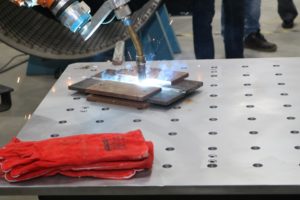Welding Safety
Safety during Welding
We are aware, that welding is a precise, reliable, cost-effective and a highly technical method for joining materials in manufacturing industries. Welding requires to generate heat using electricity, gases, base materials (that may be pre -heated), welding rods / filler materials, etc.
It is therefore very important, that we understand the safety requirements for the entire welding process.
Welding Safety Hazards
Several hazards are linked to the Welding operations for not only the welder but also to the others in the vicinity. It is important, that one is aware of these risks and hazards; understand what precautions one should take to ensure safety for all.
Work Space
At the time of welding, airborne gases & particles are generated. Good ventilation is therefore required at the work place.
Welding process produces sparks, heat and molten metal splatters which can potentially set flammable material on fire. Ensure that the workspace is free of flammable materials such as petrol, diesel, rubber, plastic, etc…
Electric Shock
Live electrical circuits are used to create a pool of molten metal during the arc welding process. One is at risk of experiencing an electric shock when welding. Electric shock is the most serious hazard posed by welding and can result in critical injuries / death – directly or from a fall from height after a shock.
One has to be particularly more cautious, if working in electrically hazardous conditions such as :
- In damp area.
- While wearing wet clothing.
- On metal flooring or structures.
- In confined spaces.
- In cramped conditions where one is required to lie, kneel or crouch.
Noise Hazards
A loud noise is considered to be above 85 dB(A). When carrying out welding activities, one is likely to be exposed to loud, prolonged noises. Welding activities such as flame cutting and air arc gouging can produce noise levels of over 100 dB(A). This can be very harmful to the ears and can result in hearing damage.
Regular or sudden exposure to loud noises can cause permanent noise-induced hearing loss, with the side effects such as :
- Ringing in the ears (tinnitus).
- Occasional dizziness (vertigo).
- Increased heart rate.
- Increased blood pressure.
Exposure to UV Radiation
Welding produces an intense bloom of UV light – looking at this directly when welding, can result in a painful and sometimes long-lasting condition called arc-eye. Never ever carry out a welding procedure without appropriate PPE & welding curtains. Many factors can affect the severity of a flash burn injury, such as distance, duration and the angle of penetration. Long-term exposure to arc flashes could also potentially result in cataracts and lead to a loss of vision.
Other forms of eye damage include:
- Foreign bodies such as grit, sparks and dust entering the eye.
- Particulate fumes and gases, which can lead to conjunctivitis.
Exposure to Fumes and Gases
Undertaking welding activities exposes one to invisible gaseous fumes such as ozone, nitrogen oxides, chromium and nickel oxides, and carbon monoxide which can easily penetrate into lungs. Depending on the gas or fume, the concentration and duration of the exposure, the resultant damage can be severe.
Illnesses caused by welding fumes and gases include:
- Regular exposure to welding fumes and gases can result in a lung infection which could then develop into pneumonia.
- Occupational asthma. Chromium oxides and nickel oxides produced by stainless steel and high nickel alloy welding can cause asthma.
- All welding fumes are internationally considered ‘carcinogenic’.
- Metal fume fever. Welding or hot work on galvanised metal and high steel weld fume exposure can often result in ‘flu-like’ symptoms
- Throat and lung irritation,including throat dryness, tickling of the throat, coughing and tight chests.
Burns
The combination of high-temperature welding arcs, UV rays and molten metal means that one is susceptible to severe burns when welding. These burns can affect the skin or eyes and can be very serious. They can also happen very quickly, without giving time to react.
Burns usually occur when welders think they can skip taking precautions for a few quick welds. This is bad practice.
Welding Safety Precautions
Ensuring high levels of safety is vital when undertaking any welding activity. Ignoring your PPE and safe working practices can have serious repercussions and might even lead to fatalities. Therefore, one should follow the safety precautions religiously.
Always Wear Appropriate PPE
- Welding helmets with side-shields. Welding helmets protect you from UV radiation, particles, debris, hot slag and chemical burns. It’s important that you wear the right lens shade for the work you are carrying out. follow the manufacturer’s guidelines and gradually adjust the lens filter until you have good visibility that does not irritate your eyes. You should also use a fire-resistant hood under your helmet to protect the back of your head.
- Respirators protect you from fumes and oxides that the welding process creates. Your respirator must be suitable for the work you are carrying out.
- Fire resistant clothing. Fire resistant clothing protects you from heat, fire and radiation created in the welding process and shields you from burns. It should have no cuffs, and pockets must be covered by flaps or taped closed. You should not use synthetic clothing. Instead, opt for leather and flame-resistant treated cotton.
- Ear protection. Ear protection protects you from noise hazards. It’s important you wear ear protection that is appropriate for the noise created in your workplace, and use fire resistant ear muffs if there is a risk of sparks or splatter entering the ear.
- Boots and gloves. Insulated, flame resistant gloves and rubber-soled, steel toe-capped safety shoes shield you from electric shocks, heat, fire, burns and falling objects.
Receive Appropriate Training
Before starting any welding work, it’s important that one takes adequate training in the welding processes & the safety precautions.


